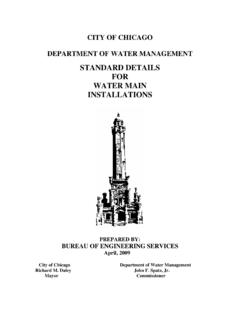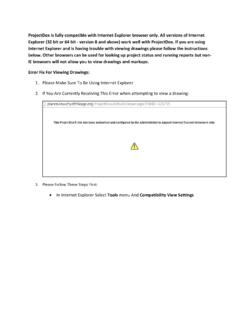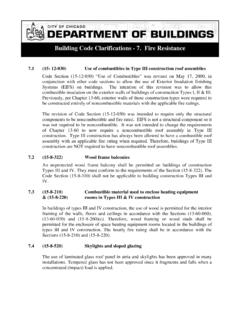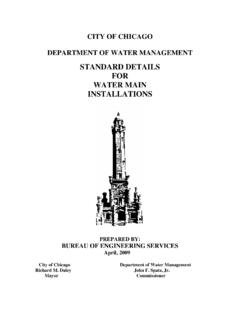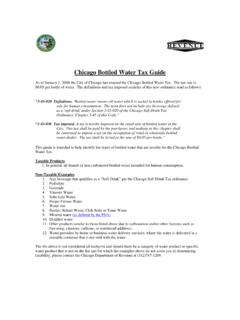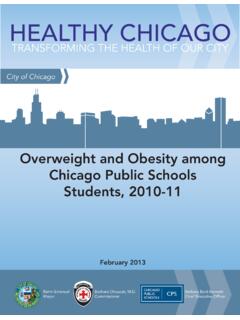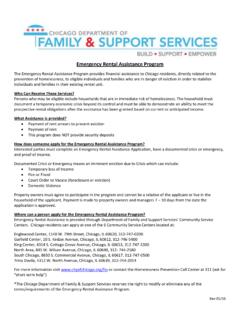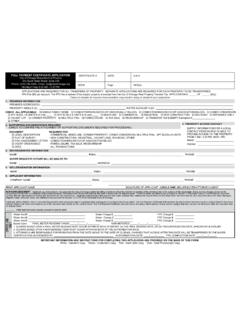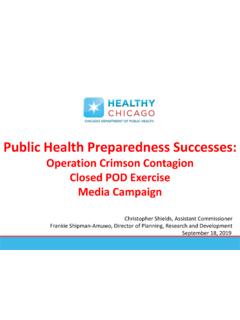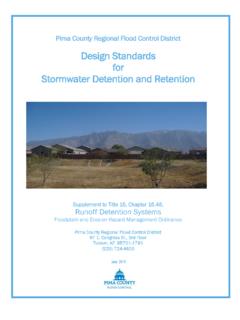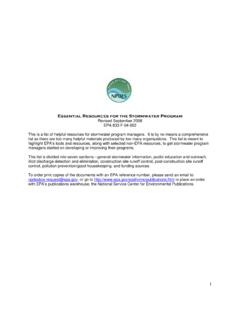Transcription of City of Chicago Stormwater Management Ordinance Manual
1 City of Chicago Stormwater Management Ordinance Manual Dept. of Water Management City of Chicago January 2016 Thomas H. Powers, PE Rahm Emanuel Commissioner Mayor Chicago Stormwater Ordinance Manual City of Chicago Stormwater Management Ordinance Manual Use of this Manual This Manual has been prepared to be used in conjunction with: Chapter 11-18 Stormwater Management of the Municipal Code of Chicago , and The Department of Water Management Regulations for Sewer Construction and Stormwater Management Updates and Revisions Updates or revisions to the Regulations and Manual may be available.
2 Please check for any available updates by going to: to check the Department of Water Management website and following these links: (Under Featured Services and Programs) click Sewer Regulations i Chicago Stormwater Ordinance Manual Table of Contents Use of this Manual .. i Updates and Revisions .. i Table of Contents ..ii Foreword ..iv General Policies and Procedures .. 1. Introduction .. 1. The Need for Stormwater 1. Stormwater Management Policy .. 2. Development Review Process .. 3. Design Responsibilities .. 4. Applicability of Performance Standards .. 4. Flow Rate Control: Managing Stormwater Leaving the Site.
3 7. Introduction and Applicability .. 7. Design 7. Allowable Release Rate .. 8. Standard Maximum Release Rate .. 9. Computed Maximum Release Rate .. 10. Outlet Sewer Capacity .. 10. Critical Local Sewer Capacity .. 10. Special Requirements .. 12. Flow Diversions .. 12. Multiple Sewer Connections .. 13. Dry Weather Flows .. 13. Unrestricted Areas .. 14. Lot-to-Lot Buildings .. 14. Side Gutters or Significant DWF .. 14. Open Space Discharging to Combined Sewers .. 15. Direct Discharge into Waters .. 15. Building Rehabilitation .. 15. Detention Design Requirements and Calculation Methods.
4 15. Restrictors .. 22. Calculation of Storage .. 22. Stormwater Capture 22. Residential Land Uses .. 22. Commercial/Industrial/Public Land Uses .. 23. Rate Control BMPs .. 23. Conveyance Structures .. 23. Detention Structures .. 24. ii Chicago Stormwater Ordinance Manual Volume Control: Managing Stormwater Onsite .. 26. Introduction and Applicability .. 26. Design Requirements and Calculation Methods .. 26. Practicability of Infiltration BMPs .. 27. Geotechnical Investigations .. 28. Underdrains .. 35. Drainage Areas and Volume Control .. 35. Direct Discharge to Waters .. 35. Alternative Volume Control Measures.
5 35. Reduction of Impervious Areas .. 35. Extended Stormwater Detention .. 36. Volume Control BMPs .. 36. Volume Control BMPs .. 36. Erosion and Sediment Control .. 41. Introduction and Applicability .. 41. General Requirements .. 42. Submittal Requirements .. 42. Development Sites Discharging to Combined Sewers .. 42. Developments Discharging to Waters .. 43. Operation and Maintenance Requirements .. 45. Introduction and Applicability .. 45. General Requirements .. 45. Owner Information .. 45. Site Map .. 45. O&M Practices .. 46. Implementation Schedule .. 46. Employee Training .. 47. References.
6 48. Appendices A. DOB Plan Review Checklist B. Hydrologic Analysis Methods C. BMP Guidesheets D. Case Studies iii Chicago Stormwater Ordinance Manual Foreword The City of Chicago (City) is committed to protecting, conserving and managing our water wisely. The City has developed Chicago 's Water Agenda 2003 (Water Agenda) to encapsulate its goals for water Management in the City and to outline its strategies for accomplishing these goals. As the quote below from the Water Agenda shows, one of the City's main concerns is Stormwater Management . When it rains, some of the Stormwater that falls in our neighborhoods soaks into the ground and some flows into the City's sewer system.
7 With more and more hard surfaces, such as rooftops and roadways, there are fewer and fewer places where rain water can infiltrate the soil, nourish plants and remain part of the natural system. Without green space to absorb it, the sewer system is required to handle more and more water. Stormwater sent to our sewers is no longer available to irrigate our lawns or recharge groundwater. Further, when the sewer system becomes full it discharges into our waterways. The City's Department of Water Management spends approximately $50 million per year to clean and upgrade 4,400 miles of sewer lines and 340,000 related structures.
8 Additionally, the City acknowledges the importance of the Tunnel and Reservoir Plan, known as Deep Tunnel, in the long- term Management of Stormwater . However, the City believes that the built infrastructure alone will not meet all of our needs for managing wastewater and Stormwater . Managing Stormwater and protecting the quality of our water resources will require a combination of upgrading our built . infrastructure and creating a green infrastructure. Through this green infrastructure, the City will demonstrate forward thinking ways to reduce the burden on our sewer system and keep Stormwater in the environment.
9 (City of Chicago , 2003). The Water Agenda details many steps that the City has taken to address Stormwater Management issues. First, it has begun promoting green building design and best Management practices (BMPs). By encouraging applicants to obtain Leadership in Energy and Environmental Design (LEED). certification and incorporate BMPs into design plans, the City hopes to reduce impacts from Stormwater runoff. Second, the City has taken steps to prevent polluted Stormwater from roadways from discharging directly into Lake Michigan and the Chicago and Calumet Rivers. The reconstruction of Wacker Drive was designed to divert first-flush Stormwater from the roadway to sewage treatment facilities.
10 Third, the City has also developed a sewer inlet control system called the Rainblocker Program to reduce combined sewer overflows and reduce basement flooding. Wherever appropriate, residents are asked to disconnect their downspouts from the sewer system and allow the downspouts to drain instead onto permeable surfaces such as lawns. The City is also working to comply with National Pollutant Discharge Elimination System (NPDES) Phase II requirements. Primarily, the City has focused on Stormwater control areas, such as areas relying on separate storm sewers and riparian areas that allow Stormwater to flow directly into water bodies.
